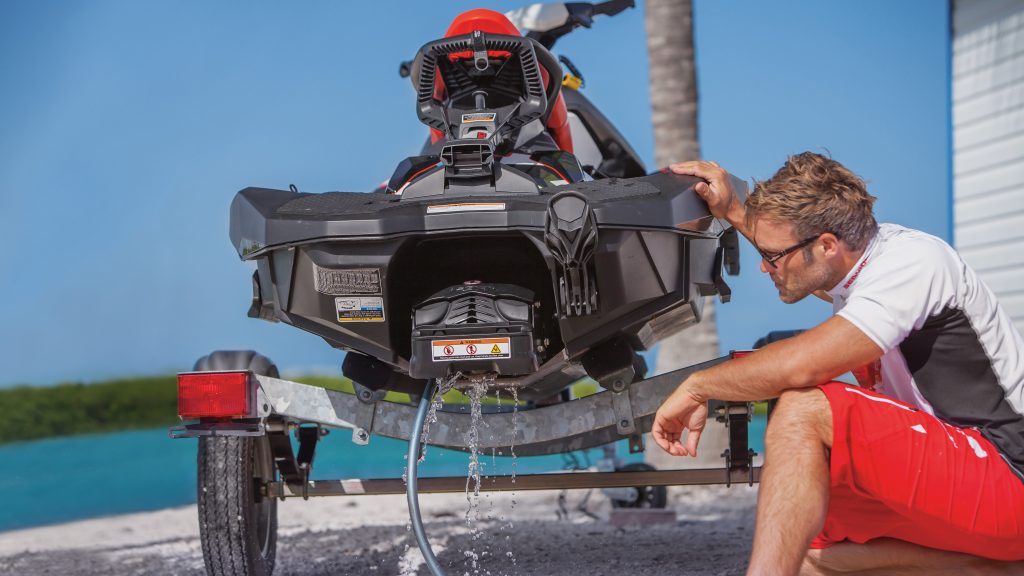When taking delivery of your new Jet Ski or personal watercraft, it can be hard to take in all the information you’re being told, especially regarding the basic maintenance required after each ride.
To be sure you don’t miss a thing, feel free to take notes and ask plenty of questions. After a day on the water, most flushing techniques are similar for all three brands, but there are subtle but important differences.
Most important: start the engine before you turn on the hose, and disconnect the hose before you switch off the engine, otherwise you will risk flooding the engine with water.
Some Jet Ski and personal watercraft owners recommend additives when flushing. We have not tested the effectiveness of flushing additives, and every Sea-Doo, Yamaha and Kawasaki expert we spoke to said a fresh-water flush without any additives is fine.
We have flushed all types of watercraft with fresh water after hundreds of hours of salt water riding over several years, and never had a problem.
How long you should flush each watercraft varies from model to model. And there are various types of water repellent or anti-corrosion spray for the engine bay. Be sure to choose one that suits your Jet Ski or personal watercraft – and one that won’t adversely affect the rubbers and seals in your particular machine.
The advice below applies to current model Jet Skis and personal watercraft. Contact a dealer about the correct maintenance for older models.
How to flush a Sea-Doo
Always start the engine just before commencing the post-ride fresh water flush, and disconnect the hose before shutting down the engine. Don’t flush Sea-Doo watercraft for longer than two minutes.
The latest models even display a warning label near the hose fitting at the rear of the craft, advising a flush time of 90 seconds to two minutes. The aim is to not overheat the carbon seal when it is out of the water. If the carbon seal wears prematurely, it can cause the craft to take on water.
Sea-Doo Spark and Spark Trixx models made from 2014 to 2020 don’t have a carbon seal (instead they have a rubber boot over the prop shaft). The exceptions are 2021 versions of the Sea-Doo Spark Trixx, which do have a carbon seal.
To avoid confusion, Sea-Doo dealers advise owners of all models (carbon seal or not) to flush their watercraft for no longer than two minutes.
How to flush a Yamaha WaveRunner
Always start the engine just before commencing the post-ride fresh water flush, and disconnect the hose before shutting down the engine. The Yamaha WaveRunners owners manual recommends the engines be flushed for three minutes (especially recommended after salt water rides), though some riders run fresh water through their engines for about five minutes or so.
Make sure the hose is connected properly and has sufficient pressure, and you can see water spill out of the jet pump and the nozzle on the side of the watercraft (two nozzles, one on each side, if it’s supercharged), to check fresh water is passing through.
How to flush a Kawasaki Jet Ski
Always start the engine just before commencing the post-ride fresh water flush, and disconnect the hose before shutting down the engine.
Unlike Sea-Doo and Yamaha models, Kawasaki Jet Skis should be flushed for five or 10 minutes (especially recommended after salt water rides). Make sure the hose is connected properly and you can see water spill out of the jet pump and the nozzle on the side, to check the fresh water is passing through.
Non-supercharged Kawasaki models only need a five-minute fresh water flush. Kawasaki experts we’ve spoken to say supercharged versions need a 10-minute fresh water flush.
Late model supercharged Kawasakis have two flush points (one for the intercooler and another for the engine). Experts recommend flushing the intercooler first for five minutes, and then flush the engine afterwards for five minutes.
That’s because any salt water inside the intercooler could bake on if the engine is flushed first.
Kawasaki experts say it is best to not use Y-type hose connectors to flush both at the same time, because most household taps don’t have sufficient water pressure to flush both properly at the same time.
The advice above is general in nature. We recommend contacting a Sea-Doo, Yamaha or Kawasaki dealer for more information on the correct flushing techniques for your specific watercraft.
MORE: All our Sea-Doo coverage in one click
MORE: 2021 Sea-Doo prices
MORE: All our Yamaha coverage in one click
MORE: 2021 Yamaha WaveRunner prices
MORE: All our Kawasaki coverage in one click
MORE: 2021 Kawasaki Jet Ski prices



